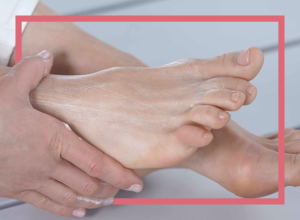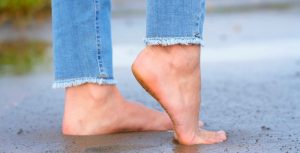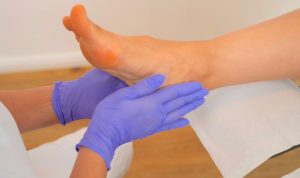Spring is just around the corner – and with it the first rays of sunshine, lighter clothing and open shoes. For many, this is the best time of the year. But while nature and the mind slowly awaken, the traces of winter are often still visible on the feet: dry skin, pressure points or calloused areas are not uncommon.
Now is the right time to get your feet back into shape and “fit” for spring. Simple care routines, gentle products and regular care help to restore the skin’s natural balance. Here’s how!
Foot check: How are your feet really doing?
Before you start caring for your feet, it’s worth taking a closer look: What condition are your feet in after the winter? If you take a moment, you can recognize many small changes yourself – and react to them in a targeted manner.
Typical signs of stressed “winter feet” are dry, cracked skin, calluses on the heels or balls of the feet and small pressure points caused by tight shoes. The nails can also be affected – for example due to a lack of air circulation or lack of care.
A simple foot check at home is often enough to identify the most important points:
- Is the skin dry or tight?
- Are there calloused areas on the heels or balls of the feet?
- Are redness or pressure marks visible?
- How do the nails look – smooth, clear and well-groomed?
Anyone who notices changes that do not improve with regular care can seek the advice of a pedicure professional. In many cases, however, a good routine is enough to restore the skin’s suppleness and support its natural balance.
Exfoliate, care, polish – “spring cleaning” for the feet
After the foot check, simple measures can help to smooth the skin, reduce calluses and make the feet look smoother overall. The following applies: less is often more – care and regularity are crucial.
Gentle foot scrub
Gentle exfoliation removes dead skin cells and makes the skin more receptive to care products. Natural scrubs with sea salt, ground nutshells or sugar and oil are suitable. Massage in circular movements, then rinse off with lukewarm water.
Gently remove calluses
Calluses are best reduced after a foot bath with a pumice stone or file – without applying too much pressure. Once a week is usually enough to maintain the skin’s natural protective function.
Relaxation with a foot bath
A warm foot bath (36-38 °C, approx. 10-15 minutes) softens the skin and prepares it for further care. Additives such as sea salt, almond oil or lavender oil support the skin and promote well-being.
Shortening and shaping nails
Nails are easier to cut after the bath – straight, not too short to avoid ingrown nails. The cuticles can be gently pushed back, cutting should be avoided.
Care with spirularin: support for stressed skin
After the preparatory care, the skin primarily needs support to regain its balance. This is exactly where Spirularin’s creams, sprays and serums come in – especially where the skin is dry or stressed.
Natural support with proven microalgae active ingredient
Spirularin products are based on a natural microalgae active ingredient called spiralin. This has been used successfully in foot care for many years. The special properties of Spirularin make the care products versatile companions for stressed skin – among other things, they support the skin barrier, have a moisturizing effect and promote natural regeneration. Spiralin has an antimicrobial effect by specifically inhibiting the adhesion and penetration of certain bacteria, viruses and fungi into the skin – without unbalancing the skin flora.
Application – easy to integrate into everyday life
It is easy to use: for example, Spirularin HF Gel is applied thinly to clean, dry feet twice a day and gently massaged in – especially on areas with dry or cracked skin. A small amount is sufficient and the gel is quickly absorbed.
Fit for spring – also from the inside
Not only external care is good for the feet – diet and exercise also play an important role in skin health and general well-being.
- Drink enough: Drinking enough water supports the skin’s natural moisture supply – including on the feet. Two liters a day is a good guideline.
- Nutrients for the skin: Magnesium, zinc and omega-3 fatty acids promote skin function and can have a supportive effect on dry or irritated skin. A balanced diet with plenty of vegetables, nuts and vegetable oils is therefore also foot care from the inside.
- Exercise & barefoot time: Short toe exercises or conscious barefoot walking – for example on the grass or on the beach – activates the foot muscles, promotes blood circulation and provides a natural feeling of lightness.
Conclusion: Keep your feet fit – even beyond spring
After winter, your feet need some attention to get them back into shape. With a regular care program – consisting of exfoliation, foot bath, callus care and high-quality care such as Spirularin – dry and stressed areas of skin can be given targeted support.
Supplemented by small impulses from the inside, such as sufficient fluids and light exercise, the skin balance can be stabilized – for well-groomed feet that are ready for the warm season. A weekly care appointment at home is often enough to keep your skin feeling good well into the summer.
Experten-Tipp entstand in Zusammenarbeit mit:
Patrick Günther
Patrick Günther completed his pharmacy studies in Hamburg and, after obtaining his licence to practise, worked for several years in marketing and sales in the pharmaceutical industry. In 2003, he took over ocean pharma, the company founded by his father in Reinbek near Hamburg in 1978. Together with his business partner, he patented the important processing and standardisation process for the microalgae active ingredient Spiralin® and developed a wide range of medical cosmetics and foot care products based on Spiralin®.







